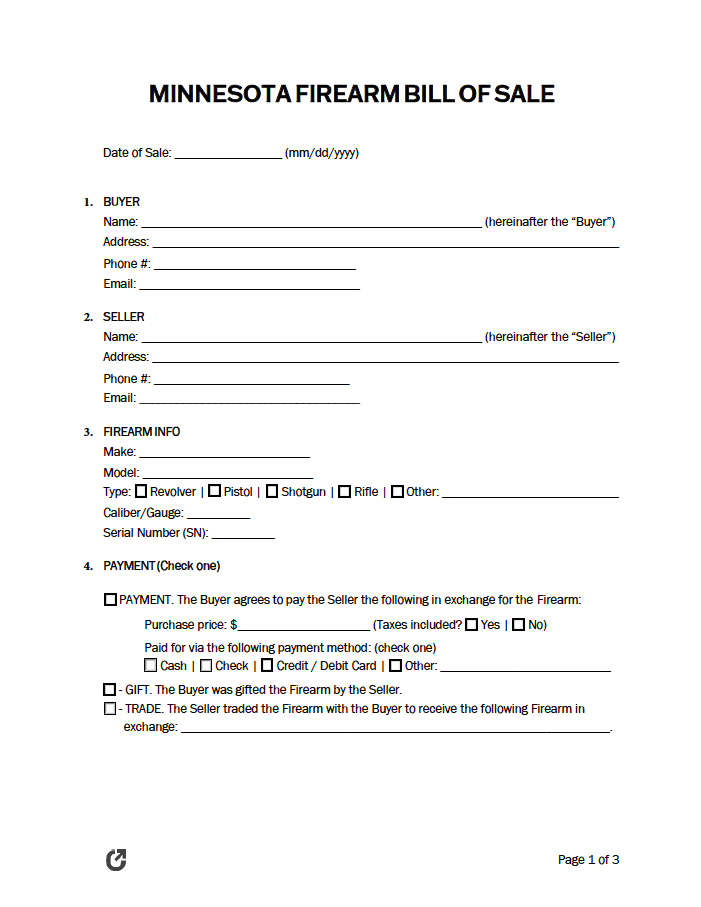Minnesota Firearm Bill of Sale Form
A Minnesota firearm bill of sale form clarifies the terms of an arrangement between one person and another. It specifically outlines the payment method, the gun’s value, and the contact details of the buyer and seller. The signatures of both parties indicate a seamless transaction without disagreement or confusion. If disputes arise, all persons named in the bill of sale form can use it to confirm the transfer and approve the conditions therein.
|
What is a Minnesota Gun Bill of Sale?
A Minnesota gun bill of sale allows non-prohibited individuals to exchange firearms by gift, trade, or cash. The document serves as a formal record of the transfer and verifies each person’s approval of the gun’s description, selling price, and purchase date.
Since the state requires both parties to have a permit to carry, both individuals must present the certification and state or federal identification (ID) to each other. This step certifies the sale as it proves that the previous and new owners can legally own and transfer firearms.
How to Apply for a Permit to Carry
Per state law, Minnesota residents must have a permit to buy, sell, or carry handguns and semiautomatic assault rifles. Individuals twenty-one (21) years or older can lawfully purchase firearms and ammunition from federally licensed dealers. Similarly, anyone eighteen (18) or older can buy semiautomatic assault rifles. However, a permit to carry does not exempt anyone from the federal background check that occurs when purchasing a gun through a licensed dealer.
Step 1 – Restrictions
Before applying, residents and non-residents must consider their mental health history and criminal background. The state has specific restrictions on who can hold a permit to carry. Therefore, applicants should closely review the qualifications before sending in the paperwork.
Individuals who have had their rights restored or dismissed charges must provide the documents from the judicial court. Otherwise, the state will reject the application without refunding the fees.
Applicants must not have:
- Charges associated with violence;
- A record of being in jail for more than one (1) year;
- Domestic violence convictions;
- Court orders or restraining orders;
- An addiction to controlled substances;
- Previously resided in a treatment facility for chemical dependence;
- Fugitive from justice charges (relating to fleeing the state to avoid trials or giving a testament);
- A dishonorable discharge from the armed forces of the United States; and/or
- Illegal alien status.
The following individuals do not need a permit:
- People who keep their gun(s) solely on their property;
- Anyone transporting the firearm from one location to another for repair work;
- Residents and non-residents carrying their firearms between work and home;
- Enthusiasts carrying a weapon in the woods or water to hunt or target shoot in an authorized area; and/or
- Citizens transporting their unloaded gun, enclosed in a box or tied package, in a car, vessel, or snowmobile.
Step 2 – Pistol Safety Training
Minnesota requires applicants to prove they completed an approved firearms safety course by sending a photocopy of the certification to their county sheriff’s office. The issuance date must fall within one (1) year of the application submission. For example, if they passed the course on April 22, 2022, they could use the certification to apply until April 22, 2023. If they apply after the deadline, they must take another safety training course.
Step 3 – Submit Paperwork
Applicants must visit their nearest county sheriff’s office to drop off the required documentation. This paperwork includes a filled, signed, and dated application and a photocopy of a certificate or affidavit verifying the completion of a pistol safety training course.
They must also make a copy of their driver’s license, state ID card, or passport photo page, include it in the forms, and provide the fees (no more than $100 per state law). If they have documents relating to a pardon or expungement to restore their rights, they must also submit the applicable documents.
The issuing county sheriff’s office completes the receipt section of the application with the person applying for a permit. This form only proves the transaction happened, meaning the applicant cannot use it as their permit to carry or transfer. Instead, they must wait to receive their approval or denial notice.
Step 4 – Processing
The state has up to thirty (30) days to process the application and provide a statement of approval or denial. If accepted, the applicant receives a permit, which they must have with their photo ID when carrying a weapon. During the “active” period, the permit holder can purchase as many guns as they want. Denied individuals must review their reason for rejection and decide if they want to reapply (depending on their eligibility status).
Step 5 – Renew
Permits expire five (5) years after the issuance date. It expires at midnight on the date listed on the license. Holders must notify their sheriff’s office of address changes and lost or damaged permits within thirty (30) days. They must also submit a notarized statement confirming the destruction or misplacement of the license. Individuals who fail to provide this information receive a “petty misdemeanor” charge.
The person renewing must present a photocopy of their firearms training certificate, which they must have taken within one (1) year of submitting the information. In addition, they must provide a copy of their state ID or driver’s license and pay the fees, which cannot exceed $75. Permit holders who renew after the expiration date but before thirty (30) days after the date must pay a $10 late fee. If they miss this deadline, they must apply as a new applicant.
